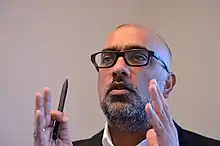Vikas Berry
Vikas Berry (born 1977, Pune, India) is an Indian-American scientist, engineer, and academic. Berry is the head of the department of chemical engineering at the University of Illinois Chicago.[1][2] He held the William H. Honstead endowed professorship at the Kansas State University from 2011 to 2014.[3] Berry is a prolific researcher and an expert in the areas of bio-interfaced two-dimensional materials and 2D nanostructures (such as graphene and graphene nanoribbons).[4][5][6][7][8][9][10]
Vikas Berry | |
|---|---|
 | |
| Born | 1977 (age 43–44) |
| Education | Chemical Engineering |
| Alma mater | Virginia Tech, University of Kansas, Indian Institute of Technology Delhi |
| Known for | Integrating Biology with 2D Nanomaterials |
| Scientific career | |
| Fields | Graphene and 2D Nanomaterials |
| Institutions | University of Illinois Chicago, Department of Chemical Engineering |
| Doctoral advisor | Ravi Saraf |
| Website | https://vikasb.people.uic.edu/ |
Research
Berry has contributed to many research areas. He has developed several bionanotechnologies, including cancer detectors, ALS sensors, microbial fuel cells, biocompatible papers, and DNA-transistors.[4][5][6] He has also developed novel nano-devices such as ultrafast detectors, photodetector, sodium-ion batteries, 3D printing gels, Raman enhancer, IR-sensor, molecular machines, and graphene liquid cells for TEM.[7][8][9] Berry has also contributed to 2D material science and technology, including nanotomy, 2D synthesis and growth,[10] non-destructive graphene functionalization, boron nitride chemistries, gold nanostructures, microwave induced reduction and nanocrystallization, wrinkles in 2D nanomaterials,[11] and 2D Composites[12]
Berry's research has been covered by several national publications, including The Economist,[5] Washington Post,[4] Wall Street Journal,[6] The Engineer,[7] Zee News,[13] New Electronics,[14] Nature,[8] and other outlets[9][15][16][17]
References
- "Berry Research Laboratory, Vikas Berry".
- "Nanotechnology Now - Press Release: Researchers use graphene quantum dots to detect humidity and pressure".
- Miller, Michael E. "Those nanobots from 'The X-Files' are now a real thing" – via www.washingtonpost.com.
- "Bugs in the system" – via The Economist.
- "A Tiny Robot Senses Humidity". March 27, 2015 – via www.wsj.com.
- Ford, Jason. "Gold standard for future electronic devices | The Engineer The Engineer". Theengineer.co.uk. Retrieved 2021-01-29.
- Brumfiel, Geoff (March 18, 2010). "It's a wrap for bacteria". Nature: news.2010.134. doi:10.1038/news.2010.134 – via DOI.org (Crossref).
- "An Introduction to Trickle-Down Graphene". AZoNano.com. August 24, 2018.
- Deng S, Sumant AV, Berry V (2018). "Strain engineering in two-dimensional nanomaterials beyond graphene". Nano Today. 22: 14–35. doi:10.1016/j.nantod.2018.07.001.
- Debbarma R, Behura S, Nguyen P, Sreeprasad TS, Berry V (2016). "Electrical transport and network percolation in graphene and boron nitride mixed-platelet structures". ACS Applied Materials & Interfaces. 8 (13): 8721–8727. doi:10.1021/acsami.6b01976. PMID 27002378.
- "Improved sensing devices may someday tell if it will rain on Mars". Zee News. May 12, 2013.
- "US researchers make graphene breakthrough". www.newelectronics.co.uk.
- "Nanotechnology Now - Press Release: Connecting materials science with biology, K-State engineers create DNA sensors that could identify cancer using material only one atom thick". www.nanotech-now.com.
- "Graphene Used As Floating-Molecular Carpet To Ornament It With 24-Carat Gold 'Snowflakes'". phys.org.
- "LIGHT MATTERS 03.30.2011". YouTube. Retrieved 2021-01-29.
External links
- Berry Research Laboratory – Page
- UIC Faculty Page for Vikas Berry
- Prof. Berry speaks about his research
- Washington Post Article on Berry's Research on Bacterial Spores in Electronic Devices
- The Economist discusses Berry's Research on Graphene Wrinkle Devices on Bacteria
- Wall Street Journal discusses Berry's Research on A Tiny Robot Senses Humidity
- Photonic Media discusses Berry's research on graphene-wrapped bacteria